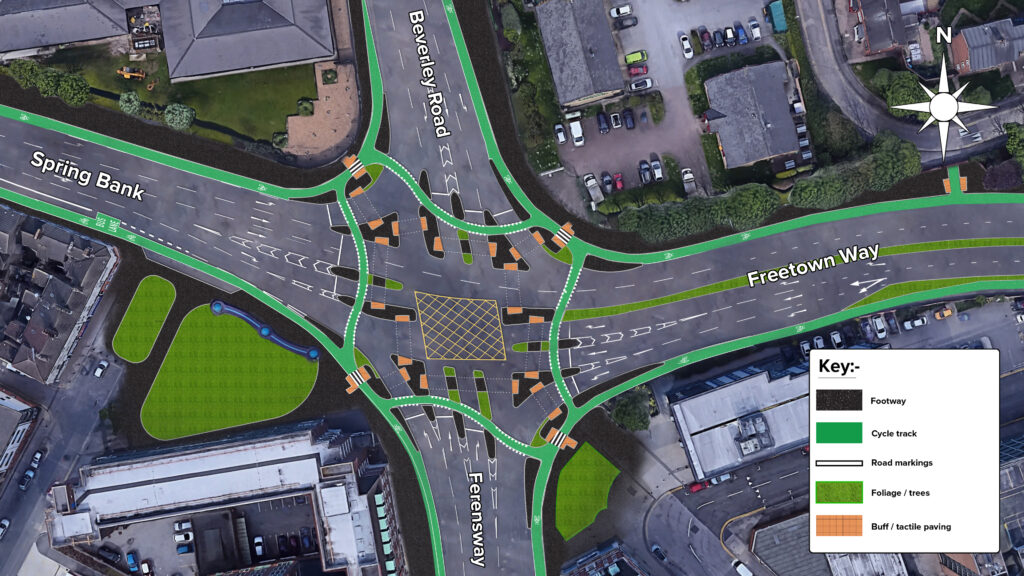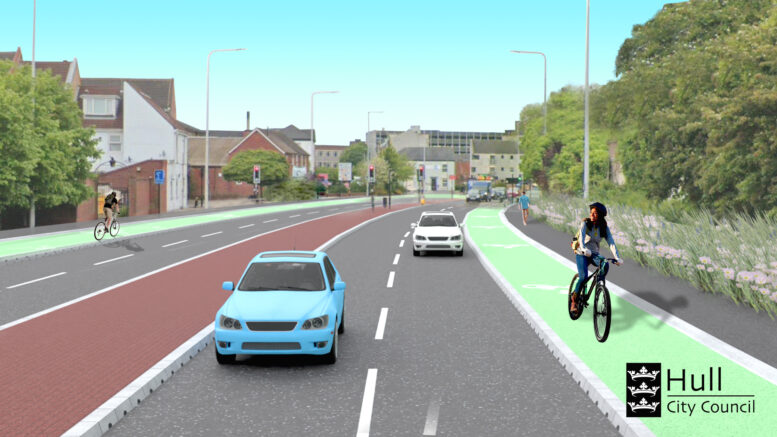Hull City Council has released two new artist’s impressions showcasing how the new cycle scheme being planned for Freetown Way could look – including the installation of the city’s first CYCLOPS junction.
The council’s contractor, Pell Frischmann Consulting Engineers Limited, is in the process of finalising design plans for the scheme, with the council aiming to go out and engage with the public and other stakeholders on these in the summer.
Securing feedback on the scheme’s design is the next milestone and will help the council finalise the necessary documents for tender. A contractor would then be appointed to deliver the scheme, with a view to starting on site in spring 2025.
The scheme will see the footways on both sides of Freetown Way widened, between Witham and Blundell’s Corner, to accommodate safe, off-road cycle lanes, providing a segregated area for both cyclists and pedestrians.
The CYCLOPS junction, proposed for Blundell’s Corner, will help improve safety for cyclists and pedestrians and is a design that is becoming more popular in towns and cities across the country.
The unique design of the CYCLOPS junction completely separates pedestrians and cyclists from motor traffic at junctions, reducing the possibility of collisions or conflict. Pedestrians are also able to get where they want to be in fewer stages with more space to wait than on other junction designs.
The scheme is funded by an allocation from Active Travel England’s Active Travel Fund (ATF), which the council successfully bid for in May 2023. In addition to Freetown Way, the council will also deliver another cycle scheme on Preston Road.
Councillor Mark Ieronimo, cabinet portfolio holder for transportation, roads and highways, said: “These new artist’s impressions help to visualise how the design for this scheme will enhance the cycling facilities on Freetown Way.
“From speaking to our residents, and through responses to the wide-ranging traffic and travel survey, undertaken in the summer of 2022, we know that improving the city’s transport network is an important priority and that our residents want us to provide the facilities needed to support greater choice when it comes to travel options.
“The plans being finalised for Freetown Way will not only provide better facilities for cyclists, but they will also deliver a range of pedestrian improvements, while restoring the road layout to two lanes in each direction.
“This scheme, and the other planned for Preston Road, not only demonstrate this council’s commitment to providing the facilities needed to encourage more people to choose active and sustainable modes of travel, like cycling, but also to enhancing the city’s highways to make them safer for the benefit of all members of the travelling public.
“Once the scheme’s design is finalised, we will seek final feedback in the summer.”

What is a CYCLOPS Junction?
CYCLOPS junctions, or cycle-optimised protected signals junctions, are appearing more and more in cities and towns across the UK.
A CYCLOPS junction segregates cyclists from motorists, prioritising the safety of people walking and cycling.
The unique design of the CYCLOPS junction completely separates pedestrians and cyclists from motor traffic at junctions, reducing the possibility of collisions or conflict. Pedestrians are also able to get where they want to be in fewer stages with more space to wait than on other junction designs.
As well as minimising the number of potential signal phasing/stages to allow for movements around the junction, the CYCLOPS has other important benefits too.
These include:
- cyclist and pedestrian phases can run simultaneously
- pedestrian crossing times are shorter and closer to desire lines, including the potential for diagonal pedestrian crossings
- cyclists have protected right turn on a gentle radius and can filter left without signal control
- journey times for all modes navigating the junctions, including motor traffic, are not negatively affected.
How does it work?
The outer ‘ring’ of the junction is a cycle path, acting like a roundabout with signal-controlled crossings. This will allow those who cycle to cross over the junction or make right turns unrestricted by cars or foot traffic, creating a safe route to travel.
The inner ‘ring’ of the junction is dedicated to pedestrians, with those walking and cycling getting the same green light signal in all directions at the same time, but on a separate ring of paths in the middle of the junction.
There are well-defined zebra crossings on each side of the junction to provide a safe place to cross the cycle lane for pedestrians.
All motorised traffic stops at the lights whilst cyclists and pedestrians have their green light signal.
Once pedestrians and cyclists have passed, motorised traffic will get the green light signal to continue driving and use the junction like normal.




